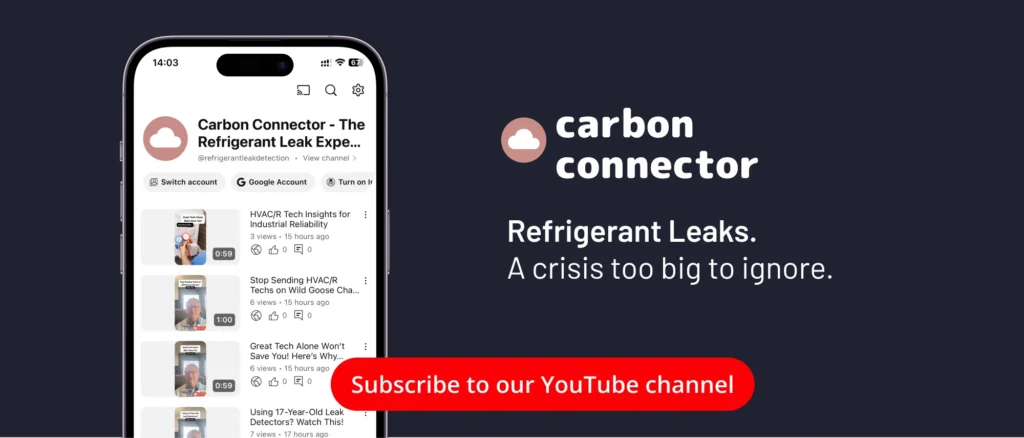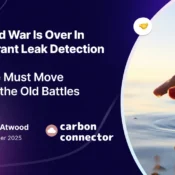
After The CARB Workshop: Why SB 253 Compliance Starts With Refrigerant Leak Detection
Table of Contents
ToggleA Recent Stress Test
On August 21, California’s Air Resources Board (CARB) held a three-hour workshop on the state’s new climate disclosure laws: SB 253 (Climate Corporate Data Accountability Act) and SB 261 (Climate-Related Financial Risk).
It wasn’t just another webinar. 👇
With hundreds of participants, more than 90 hands raised, and questions firing nonstop, it became a live stress test: could companies make sense of the rules, align their reporting systems, and trust that their efforts would be counted?
The answer: clarity is building, but confusion remains. Deadlines, data years, assurance, Scope 3, fees, parent–subsidiary rules, and the definition of “doing business in California” all drew waves of questions.
CARB provided guidance (often pointing back to FAQs or “good faith” expectations) but leaned heavily on enforcement discretion and public comment, emphasizing that demonstrating a good faith effort and making good faith efforts toward compliance will be central to the regulatory approach, especially in the early years.
📌 For anyone watching, it confirmed what many suspected: the rules are real, the deadlines are fixed, and the market is only partially ready.
These statutory reporting timelines are mandated by California law and remain unchanged, underscoring the need for proactive compliance.

Deadlines and Data Years – “Is 2024 Enough?”
Timing dominated the questions.
Many pressed for clarity on whether 2024 emissions data would satisfy the first SB 261 reports due January 1, 2026.
These compliance deadlines are set by statutory reporting timelines, and companies must proactively prepare to meet them.
“If that’s for prior year, is this really looking at 2024 data for 261, or must we deliver 2025 in time?”
CARB’s answer:
Use the most recent data available. If 2024 is all you have, that’s acceptable; if you can compile 2025 in time, that’s better.
For SB 253, CARB confirmed:
Assured Scope 1 and 2 emissions must be reported by June 30, 2026, tied to FY 2025 data. Companies are required to disclose GHG emissions annually as part of SB 253. Scope 3 follows in 2027.
One participant summed up the tension:
“We’re already struggling to get reliable Scope 1 data. How are we supposed to validate Scope 3 by 2027?”
Accurate emissions calculations and compiling full carbon inventories are essential to meet these reporting requirements.
CARB’s response was firm:
The deadlines are statutory and will not move.

Fees, Coverage, and “Doing Business in California”
Another theme was applicability.
- Annual fees under SB 261 apply even in non-reporting years.
- Companies that only sell into California but aren’t headquartered there? Covered, if their annual revenues or total annual revenue meet the threshold for compliance.
- CARB described cross-checking national revenue data with the California Secretary of State listings to identify likely covered entities, but stressed that self-assessment remains the company’s responsibility.
SB 253 applies to both public and private companies, including private companies, that have a total annual revenue of $1 billion or more and do business in California.
Questions around appeals, accuracy, and whether the state’s list would be definitive remain unsettled.
Assurance and Verification: Who Can Verify, and When?
The assurance discussion revealed both urgency and anxiety.
- CARB will not create a new accreditation system — instead relying on existing frameworks (ISO, ISSA, AA1000, AICPA).
- Independence matters: if you built the inventory, you cannot also verify it.
- Stakeholders asked whether assurance deadlines could be staggered to reduce calendar pressure.
- Limited assurance by a third-party verifier will be required for Scope 1 and 2 emissions starting in 2026, with a transition to more rigorous reasonable assurance standards by 2030.
📌 CARB acknowledged the challenge: thousands of reporters, limited verifier capacity. Written feedback is actively being sought.
Scope 3 Greenhouse Gas Emissions – The Flashpoint
Scope 3 drew some of the most pointed questions.
How to handle double-counting, unverifiable supplier data, and investor pressure for reconciliation with financials?
Scope 3 includes indirect emissions and other indirect emissions, which are key components of a company’s value chain and present significant challenges for accurate reporting and compliance.
Additionally, accounting for purchased electricity as part of Scope 2 is essential, as it impacts comprehensive Scope 3 reporting and overall greenhouse gas inventories.
“Our investors already ask why we can’t reconcile Scope 3 with financials. Now California wants it verified? That feels impossible.”
CARB reiterated: Scope 3 is not required in the first SB 261 cycle, but it is required under SB 253 by 2027.
Transparency on methodology will be key.
Measuring and reporting carbon footprints in line with greenhouse gas protocol standards is increasingly important for meeting investor expectations and regulatory requirements.
Assurance thresholds (all categories vs. only material ones) remain under discussion.
✔ Protect your budget. Start smarter leak detection today.

Stakeholder Confusion on Display
The workshop wasn’t about debating climate policy; it was about people trying to figure out how to survive the rules. Disclosure requirements and climate disclosure requirements were key sources of confusion, as companies sought clarity on what exactly must be reported and how to comply.
“We’ve invested in CDP for years — is that enough?”
→ No. Helpful, but statutory compliance with independent assurance is required.
“If my fiscal year ends in March, do I still hit June 30?”
→ Yes. SB 253 is tied to the prior fiscal year; CARB encouraged written feedback on feasibility.
“Does a UK parent/U.S. subsidiary setup count?”
→ Yes, if the U.S. entity is doing business in California and meets thresholds.
Even well-prepared companies admitted uncertainty.
As one participant put it:
“We left with more answers, but also more to-do’s.”
📌 Companies recognized the need to provide stakeholders with clear, transparent information to enhance transparency and build trust as they navigate these new requirements.
Why Leak Detection Belongs in Every SB 253 Budget
Here’s where the workshop connects directly to refrigerants.
Amidst all the regulatory fog around Scope 3 and assurance standards, the most practical, controllable lever for Scope 1 emissions is managing fugitive emissions from refrigeration systems and Air Conditioning Systems.
Why?
Because fugitive refrigerant emissions are Scope 1 by definition, they carry outsized Global Warming Potentials (GWPs), and they will be the very first category to face assurance review under SB 253.
Effective leak detection and repair not only ensures compliance but also reduces a company’s environmental impact and overall climate impact.
📌 These efforts can drive significant carbon reductions in line with California’s climate goals.
The GWP Reality Check
Refrigerants aren’t just another emission source; they’re a multiplier.
- A 50 lb leak of CO₂ = 0.02 tCO₂e — essentially negligible.
- A 50 lb leak of R-410A (GWP ~2,088) = ~47 tCO₂e, equivalent to driving a gas-powered car 115,000 miles.
- A 50 lb leak of R-404A (GWP ~3,900) = ~88 tCO₂e, equivalent to a transatlantic flight for 200 passengers.
Accurate carbon accounting and maintaining comprehensive carbon inventories are essential for regulatory compliance, especially under California SB 253.
Quantified refrigerant leaks must be included in emissions disclosures, as companies are required to report all relevant greenhouse gas emissions across Scope 1, 2, and 3.
This is why refrigerants often make up the majority of a company’s Scope 1 footprint — and why a single unnoticed leak can derail compliance math overnight.
Budget Defense: Why Detection Pays for Itself
In a crowded climate budget, leak detection can look optional. It isn’t.
It’s budget insurance:
✔ Avoid year-end Scope 1 surprises
when verifiers flag unexplained losses.
✔ Avoid audit overruns
caused by messy logs and missing evidence. Robust data collection systems are essential for accurately tracking refrigerant use and losses.
✔ Avoid insurance premium hikes
As underwriters increasingly price refrigerant risk. Integrating emissions and leak data with financial data supports comprehensive risk management.
✔ Cut costs directly
Every pound of HFC not leaked saves $15–$30 on replacement refrigerant, plus labor and downtime.
Leak detection is the rare compliance expense that also pays back operationally.
Engaging sustainability consultants can help optimize leak detection strategies and ensure regulatory compliance.
✔ Detect leaks before they drain your budget.
Leak Detection in the Compliance Arc
Think of refrigerant management as the sentry at every stage of the disclosure timeline:
Today (2025)
Good faith and most recent data. Refrigerants are where you can demonstrate hard evidence, not just estimates.
2026
Assured Scope 1 & 2: refrigerants will be audited first.
2027
Scope 3: refrigerant supply chains and transitions enter the picture.
Beyond
Equipment replacement, low-GWP conversions, and alignment with SEC/CSRD.
As the California Air Resources Board (CARB) is expected to adopt implementing regulations for SB-261, companies should anticipate further implementing regulations that will clarify definitions, scope, and compliance procedures throughout this timeline.
Leak detection anchors the first mile (Scope 1 assurance) and positions you for the last mile (strategic transition), and early compliance with leak detection positions companies as leaders in sustainability.

Climate Disclosure and Financial Risk
As climate disclosure laws like SB 253 reshape the regulatory landscape, the link between environmental responsibility and financial risk has never been clearer.
The California Air Resources Board (CARB) is setting a new standard for corporate transparency, requiring companies to publicly disclose their greenhouse gas (GHG) emissions and climate-related financial risks.
These requirements are not just about compliance; they are about protecting your business from the growing financial and reputational risks associated with climate change.
For companies operating in California or meeting the state’s revenue thresholds, climate disclosure is now a core part of risk management.
Accurate emissions reporting and transparent climate disclosures are essential to meet regulatory requirements, avoid significant financial penalties, and maintain stakeholder trust.
As climate-related financial risks become a central concern for investors, insurers, and regulators, companies must ensure their climate data is reliable, their reporting is timely, and their compliance efforts are proactive.
The Cost of Non-Compliance
Failing to comply with climate disclosure laws such as SB 253 can have serious financial and reputational consequences.
The California Air Resources Board (CARB) has the authority to impose significant financial penalties—up to $500,000 per violation—on companies that do not meet GHG emissions reporting requirements.
Beyond regulatory fines, non-compliance can trigger legal action from investors and stakeholders who expect transparent disclosure of climate-related financial risks.
This can lead to costly litigation, loss of investor confidence, and long-term damage to a company’s reputation.
In today’s environment, climate disclosure is not optional. Companies must prioritize proactive compliance by establishing robust systems for emissions reporting and climate-related financial risk management.
Meeting reporting requirements on time and with accuracy is essential to avoid penalties, protect corporate reputation, and maintain the trust of customers, investors, and regulators.
→ Read About “Budget Reality: Where the Money Currently Leaks”
📌 The cost of non-compliance far outweighs the investment in building a reliable climate disclosure program.

How Accurate Leak Detection Mitigates Financial Exposure
Accurate leak detection is a powerful tool for reducing financial exposure tied to refrigerant emissions: a major source of GHG emissions for many companies.
By investing in advanced carbon management tools and technologies, such as real-time monitoring and data analytics platforms, companies can quickly identify and repair refrigerant leaks.
This not only ensures compliance with emissions reporting requirements but also helps reduce overall GHG emissions, supporting broader corporate sustainability goals.
Effective leak detection and repair strategies translate directly into cost savings by minimizing product loss, reducing the need for expensive refrigerant replacements, and lowering the risk of regulatory penalties.
Moreover, by demonstrating a commitment to environmental stewardship and responsible carbon management, companies can strengthen their sustainability credentials and enhance operational efficiency.
📌 Accurate leak detection is a practical step that supports both compliance and long-term business resilience.
Building Investor and Stakeholder Confidence
Transparent and reliable climate disclosures are essential for building confidence among investors and stakeholders.
By providing accurate data on GHG emissions and climate-related financial risks, companies demonstrate their commitment to corporate climate accountability and responsible governance.
Third-party assurance (such as reasonable assurance) adds an extra layer of credibility, assuring stakeholders that the reported data is trustworthy and meets regulatory standards.
Prioritizing climate accountability and environmental responsibility not only reduces exposure to climate-related risks but also enhances a company’s reputation in the marketplace.
Investors and stakeholders are increasingly seeking out companies that lead on climate disclosures and sustainability.
By adopting a proactive approach to climate disclosure, supported by reliable data and third-party assurance, companies can attract investment, foster stakeholder trust, and position themselves for long-term success in a rapidly evolving regulatory environment.
✔ Turn leak detection into your budget’s best defense.
From Regulatory Fog to Actionable Control
However, remote monitoring technologies can help overcome some of these challenges by providing real-time data and automated alerts.
For effective troubleshooting and optimization, understanding the key components of the system is crucial.

Supply Chain Considerations
The CARB workshop revealed two truths: clarity is building, but confusion is real. Stakeholders are still wrestling with applicability, fiscal years, and Scope 3 feasibility.
The volume of questions showed how unsettled the terrain remains.
But leaks don’t wait for guidance. And refrigerants (with their extraordinary GWP multipliers) represent both the biggest near-term risk and the clearest near-term win.
By keeping leak detection in the 2025–2027 budget, companies can:
Stabilize Scope 1 reporting
Ahead of the June 30, 2026 assurance deadline. Proactive leak detection helps ensure compliance with SB 253 by meeting legal and regulatory requirements for accurate emissions reporting.
Build audit-ready evidence
That satisfies third-party verifiers.
Avoid costly surprises
That surface only after the fiscal year closes. Effective leak detection also supports efforts to reduce greenhouse gas emissions, minimizing regulatory and financial risks.
Tell a stronger story
In SB 261 about governance, risk controls, and resilience.
The workshop tempo was urgent, at times anxious: 90 hands raised, few definitive answers.
Leak detection is how you cut through that uncertainty. It turns “good faith” into hard proof, prevents Scope 1 from being your Achilles’ heel, and proves to regulators, investors, and insurers that you are in control.
Maintaining full carbon inventories, including all emission sources, is essential for transparency and accountability.
The rules may evolve. The deadlines will not.
And while Scope 3 remains a foggy horizon, Scope 1 refrigerants are today’s litmus test.
📌 The companies that invest now will not only comply: they’ll lead.
Aligning with global sustainability standards and guidance from the International Sustainability Standards Board further strengthens your corporate climate strategy and demonstrates leadership in climate disclosure.




